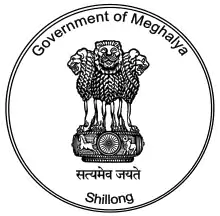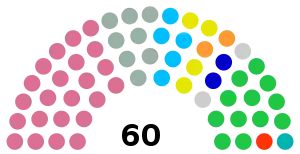Meghalaya Legislative Assembly
The Meghalaya Legislative Assembly is the unicameral legislature of the Indian state of Meghalaya.[2]
Meghalaya Legislative Assembly | |
|---|---|
| 10th Legislative Assembly of Meghalaya | |
 | |
| Type | |
| Type | |
Term limits | 5 years |
| Leadership | |
Speaker | |
Deputy Speaker | |
Leader of the Opposition | |
| Structure | |
| Seats | 60 |
 | |
Political groups | Government (46) MDA(46) Opposition (12)
Others (2) |
| Elections | |
| First past the post | |
Last election | 27 February 2018 |
Next election | February 2023 |
| Meeting place | |
| Vidhana Bhavan, Shillong, Meghalaya, India | |
| Website | |
| http://megassembly.gov.in/ | |
Constituted as a directly elected body in 1972, it has 60 members, filled through direct elections held every five years.[2] Like other Indian states, Meghalaya has a parliamentary system of government. The executive branch of the Meghalaya Government is derived from the Legislative Assembly.
History
In independent India, the areas now constituting the state of Meghalaya were part of the state of Assam and represented in the Assam Legislative Assembly. The Indian Parliament passed the Assam Reorganisation (Meghalaya) Act in 1969, which led to the establishment of an autonomous state of Meghalaya within Assam on 2 April 1970.[2][3] A legislature of 37 members for the new autonomous state was established, with representatives elected indirectly by the autonomous direct councils.[2][3] The first sitting of the assembly took place in Tura on 14 April 1970. In 1971, the Indian Parliament passed the North-Eastern Areas (Reorganisation) Act, which converted Meghalaya from an autonomous state within Assam to a full member state of the Indian Union.[2] The State of Meghalaya was officially formed on 21 January 1972.[2] The Legislative Assembly was then reconstituted as a directly elected body.
The regions of Meghalaya are represented in the Assembly, with 29 members elected from Khasi Hills, 7 from Jaintia Hills and 24 from Garo Hills.[4]
List of Assemblies
The following is the list of all the Meghalaya Legislative Assemblies:[5]
| Assembly | Term of Assembly | Speaker | Term of Speaker | Leader of House (Chief Minister) |
Term of Leader of House | Party of Leader of House[lower-alpha 1] | Remarks | ||||
|---|---|---|---|---|---|---|---|---|---|---|---|
| 1st Assembly | 1972 | 1978 | R. S. Lyngdoh | 25 March 1972 | 1978 | Williamson A. Sangma | 18 March 1972 | 21 November 1976 | All Party Hill Leaders Conference (APHLC) | --- | |
| 22 November 1976 | 3 March 1978 | Indian National Congress (INC) | |||||||||
| 2nd Assembly | 1978 | 1983 | W. Syiemiong | 20 March 1978 | 1983 | D. D. Pugh | 10 March 1978 | 6 May 1979 | APHLC | --- | |
| B. B. Lyngdoh | 7 May 1979 | 7 May 1981 | APHLC | ||||||||
| Williamson A. Sangma | 7 May 1981 | 24 February 1983 | INC | ||||||||
| 3rd Assembly | 1983 | 1988 | E. K. Mawlong | 9 March 1983 | 12 December 1988 | B. B. Lyngdoh | 2 March 1983 | 31 March 1983 | APHLC | --- | |
| Williamson A. Sangma | 2 April 1983 | 5 February 1988 | INC | ||||||||
| 4th Assembly | 1988 | 1993 | P. G. Marbaniang | 24 February 1988 | 15 December 1989 | Purno A. Sangma | 6 February 1988 | 25 March 1990 | INC | --- | |
| P. R. Kyndiah | 20 December 1989 | 1993 | B. B. Lyngdoh | 26 March 1990 | 10 October 1991 | Hill People's Union | |||||
| President's Rule[lower-alpha 2] | 11 October 1991 | 5 February 1992 | NA | ||||||||
| P. R. Kyndiah | 20 December 1989 | 1993 | D.D. Lapang | 5 February 1992 | 19 February 1993 | INC | |||||
| 5th Assembly | 1993 | 1998 | J. D. Rymbai | 12 October 1993 | 17 April 1997 | S. C. Marak | 19 February 1993 | 27 February 1998 | INC | --- | |
| Monindra Rava | 22 July 1997 | 6 March 1998 | |||||||||
| 6th Assembly | 1998 | 2003 | E. K. Mawlong | 10 March 1998 | 8 March 2000 | S. C. Marak | 27 February 1998 | 10 March 1998 | INC | Though the Leader was an Independent, the government was a coalition of NCP, etc. Khonglam became the first independent Chief Minister of an Indian state in history. | |
| B. B. Lyngdoh | 10 March 1998 | 14 October 1999 | INC | ||||||||
| B. B. Lyngdoh | 14 October 1999 | 8 March 2000 | United Democratic Party (UDP) | ||||||||
| E. D. Marak | 20 July 2000 | 2 March 2003 | |||||||||
| E. K. Mawlong | 8 March 2000 | 8 December 2001 | United Democratic Party (UDP) | ||||||||
| F. A. Khonglam | 8 December 2001 | 4 March 2003 | Independent | ||||||||
| 7th Assembly | 2003 | 2008 | M. M. Danggo | 12 March 2003 | 7 March 2008 | D.D. Lapang | 4 March 2003 | 15 June 2006 | INC | --- | |
| J. D. Rymbai | 15 June 2006 | 10 March 2007 | INC | ||||||||
| D.D. Lapang | 10 March 2007 | 7 March 2008 | INC | ||||||||
| 8th Assembly | 2008 | 2013 | Bindo Lanong | 20 March 2008 | 15 May 2009 | D. D. Lapang | 10 March 2008 | 19 March 2008 | INC | INC got the highest number of seats (25) but since no majority could be secured by it even after gaining 3 Independents' support, Lapang resigned as Chief Minister in less than 10 days. Then a coalition called Meghalaya Progressive Alliance was formed, comprising all non-Congress parties like NCP (15), UDP (11), HSPDP (2), KHNAM (1) and Independents (3), thus 33 in total, to form the government under Roy. However, the coalition barely survived a year and collapsed leading to promulgation of President's Rule. After a month, several parties of the Alliance left and supported Congress to form the government with Lapang again being sworn in as the Chief Minister. | |
| Donkupar Roy | 19 March 2008 | 19 March 2009 | United Democratic Party (UDP) | ||||||||
| President's Rule[lower-alpha 2] | 19 March 2009 | 13 April 2009 | NA | ||||||||
| Charles Pyngrope | 25 May 2009 | ? | D. D. Lapang | 13 April 2009 | 18 April 2010 | INC | |||||
| Mukul Sangma | 20 April 2010 | 5 March 2013 | INC | ||||||||
| 9th Assembly | 2013 | 2018 | A. T. Mondal | March 2013 | March 2018 | Mukul Sangma | 5 March 2013 | 6 March 2018 | INC | --- | |
| 10th Assembly | 2018 | present | Donkupar Roy | 6 March 2018 | present | Conrad Sangma | 6 March 2018 | present | National People's Party (NPP) | The NDA government was formed by the coalition of 39 MLA's including NPP (20), UDP (8), PDF (4), HSPDP (2), BJP (2) and (2)Independents with Conrad Sangma as Leader of the House.[7] | |
Office-bearers
The office-bearers of the 10th Legislative Assembly of Meghalaya are:
| Designation | Name |
|---|---|
| Speaker | Metbah Lyngdoh |
| Deputy Speaker | Timothy Shira |
| Leader of the House (Chief Minister) | Conrad Sangma |
| Leader of the Opposition | Mukul Sangma |
Committees
There are 15 committees in the Legislative Assembly of Meghalaya:[8]
- Business Advisory Committee: decides the time-table for assembly functions and for evaluation of legislation.
- Committee on Petitions: responsible for examining petitions submitted to the assembly, collecting evidence and preparing reports.
- Committee on Public Accounts: examines the budget, appropriations and auditing of state agencies, programmes and government.
- Committee on Public Undertakings: responsible for monitoring and improving the workings of public sector undertakings such as government corporations, housing programmes and economic development schemes.
- Committee on Estimates: evaluates statistics and estimates to improve the efficiency and administration of various government functions, agencies and programmes.
- Committee Welfare of the Scheduled Tribes & Scheduled Castes: responsible for monitoring programmes aimed for the economic and social development of the scheduled castes, tribes and backward classes residing in the state of Meghalaya.
- Committee of Privileges: examines any issues and violations of the privileges, conduct and benefits given to members of the assembly.
- Committee on Subordinate Legislation: monitors if the state government's functions and legislation comply with the state constitution.
- Committee on Government Assurances: monitors the reliability and fulfillment of targets and promises made by the chief minister and cabinet ministers.
- Rules Committee: maintains the rules of business and code of conduct for members of the assembly.
- House Committee: oversees the amenities for members of the assembly such as housing, food, health-care and transport.
- Library Committee: is responsible for the maintenance and development of the state government and assembly library.
- Select Committee: is charged with the examination and development of specific legislation, preparing it for final passage.
- Committee on the Empowerment of Women: oversees schemes and programmes aimed to increase representation of women in society and economic sectors.
- Budget Committee: examines budget proposals for various organs and departments of the state government.
Members of Legislative Assembly
References
- Footnotes
- This column only names the chief minister's party. The state government he headed may have been a complex coalition of several parties and independents; these are not listed here.
- President's rule may be imposed when the "government in a state is not able to function as per the Constitution", which often happens because no party or coalition has a majority in the assembly. When President's rule is in force in a state, its council of ministers stands dissolved. The office of chief minister thus lies vacant, and the administration is taken over by the governor, who functions on behalf of the central government. At times, the legislative assembly also stands dissolved.[6]
- References
- "Meghalaya: All 5 Congress MLAs join BJP-backed MDA | Shillong News - Times of India". The Times of India. Retrieved 13 February 2022.
- "Meghalaya Legislative Assembly". National Informatics Centre.
- Hamlet Bareh (2001). Encyclopaedia of North-East India: Meghalaya. Mittal Publications. pp. 9–12. ISBN 978-81-7099-791-7.
- "Homepage: Office of the Chief Electoral Officer, Government of Meghalaya". Chief Electoral Officer, Government of Meghalaya.
- "Meghalaya Legislature, Mumbai" (PDF). Legislative Bodies in India website. Retrieved 13 November 2010.
- Amberish K. Diwanji. "A dummy's guide to President's rule". Rediff.com. 15 March 2005.
- "Meghalaya bypolls: MDA ties up with NPP, UDP after parties win by-elections, increases tally to 39 seats". Firstpost. 27 August 2018.
- "Meghalaya Legislative Assembly Committees". National Informatics Centre.
- "Congress mulls legal action as 12 MLAs join TMC, make it main opposition in Meghalaya". The Times of India. 26 November 2021. Retrieved 29 November 2021.
{{cite web}}: CS1 maint: url-status (link) - "Final Result Sheet - Election to the Meghalaya Legislative Assembly from the 43-Williamnagar(ST) Assembly Constituency" (PDF). ceomeghalaya.nic.in. Retrieved 31 January 2021.
- "Members of Meghalaya Legislative Assembly". Meghalaya Government Portal. Retrieved 25 November 2021.